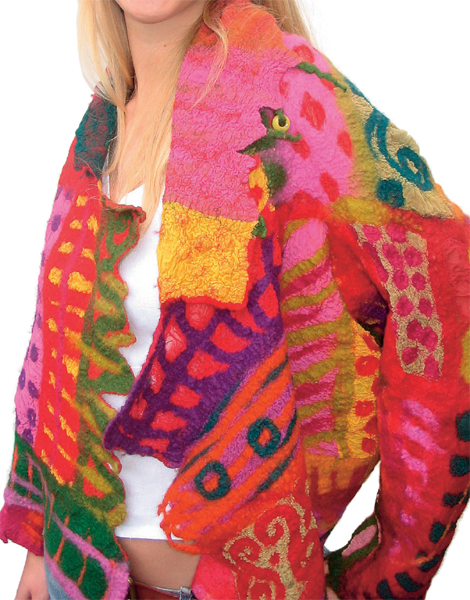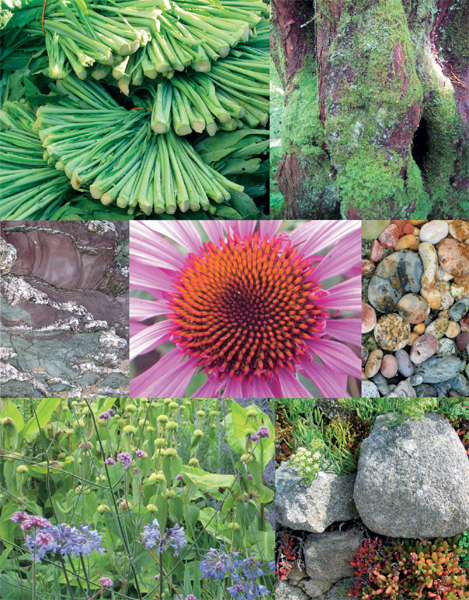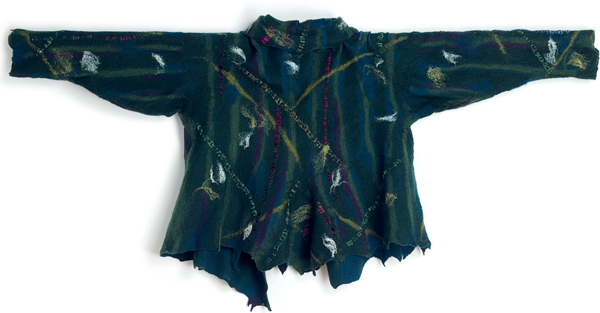

Felting Fashion
Creative and inspirational
techniques for felt-makers
Lizzie Houghton

Contents
Introduction

Felt, the most ancient of all textiles, is a marvellous material. It can be shaped, moulded and sculpted and it repels water and dirt; for these reasons it has a long history of being used for clothing, headwear and footwear, too.
I originally trained as a fashion designer and had been working for years making clothing using embroidery and appliqu. It was when I was introduced to the techniques of making fine felt and clothing that I became hooked on feltmaking. Up until then, I had really only seen fairly thick felt and, thinking it would be rather suitable as a base for machine embroidery, made some rather lumpy stuff, taking instruction from a book. It was nice to stitch on, but I now know that it was quite badly made.
The first workshop that I attended was to make a coat. I am eternally grateful for having been allowed to join this class, because at that stage I was a real novice and I didnt really know how to lay the wool thinly and evenly. I also thought that it was necessary to use far more layers of wool.
The project was huge, and while making it I remember thinking that I would never make another one. However, I did keep working on it after the weekend course, and managed to finish it during the following week. Little did I realise that several years on I would be spending all my time making only felt garments and accessories.
Making seamless felt clothing does require a large amount of space, but the shapes can be quite simple and extra fullness can be shrunk away or even moulded on the body.
Nuno felt was a greater revelation to me. The fineness and fluidity was unlike anything I had ever seen before, and so suitable for making clothing. I have always loved colour, pattern and texture, and the textures possible using this technique know no bounds!

Nuno-felt jacket made on a base of patchwork silk chiffons. The jacket is worn upside down here for an alternative look.

Very fine nuno-felt jacket showing many textures where different weights of silk have been used. The jacket is reversible and is shown here with the silk fabric on the outside.
About this book
All feltmakers will work in different ways. Although there are some elements of the process that are essential, the ways that they are put into practice are very varied. Although some methods may be more traditional, none are right or wrong. If it works it works!
This book is intended to inspire feltmakers and encourage them to have a go at making a one-off individual garment that is a piece of wearable art. There are instructions on how to make small items for beginners, such as corsages and jewellery, and there are patterns and diagrams, with guidance, for making more ambitious projects for those who have more experience. Precise instructions are given for using different techniques and for creating exciting and interesting effects. The intention is not to show how to make an exact copy of the photographed items, but more how to select and design your own individual one. Various techniques and methods are described and if you have mastered one of them then you will be able to follow the guidelines and make a felted wearable, be it a brooch, a scarf, a hat or a jacket. With practice you will be able to make them all.
I am very grateful to those great feltmakers who have so generously provided images of their work. They have inspired me and the inclusion of their work allows the reader a glimpse into the world of international contemporary feltmakers.
Inspiration

Much of my own inspiration comes from the natural world and other aspects of my surroundings also inspire me. A digital camera is a marvellous invention for me as it means I can capture everything I wish and it is not an extravagance to take as many photos as I like. I have mine with me most of the time. However, it does not mean that I consciously use all this inspiration directly in my work, just that I am absorbing colours, textures and shapes into my visual imagination.
I love flowers, the shape, colour and form of them, such as the minute patterns on petals and leaves, the odd dot of colour in the centre; the spotty petalled lily, stamens with brilliant orange chenille anthers dangling, carefully balanced on the end; checks, stripes and spots on fritillaries, foxgloves and delicate chiffon-like irises. Statuesque echiums, growing ridiculously tall and at strange angles; enormous aeoniums, rosettes of rich purple with acid-yellow flowers sprouting occasionally. The shapes and form of cacti and succulents, wonderful tree trunks and bark, covered with lichen and moss, and all the other plants to be found in sub-tropical gardens never fail to inspire. Beaches are a great source of fascination too: swirly and pearlescent shells with intricate patterns and textures; sea glass and stones in myriad colours and markings; rocks with strata and cracks resembling shibori dyeing, rockpools and glorious seaweeds with frills and contours that could have been made from nuno felt.
Inspiration can come from further afield too, from holidays to pictures in magazines and travel advertisements. Or it can come from the most unlikely places Sunday markets, decaying buildings or shady side streets. There are exotic African, Asian and Mediterranean markets with their colourful fabric, flower and produce stalls; intriguing fruit and vegetables piled together or beautifully arranged, and fish with iridescent patterned skins. Also layers of flaking paint and rusty metal eroded after battling with the elements.

How I work

Nuno-felt jacket, showing shaping at the back. Silks and velvets have been laid into the wool during the making.
I have quite a strong visual imagination and when I am about to begin making a new garment, I think about it and see it in my minds eye before making diagrams with measurements that indicate how to cut the fabric or pattern. Then begins the fun part, and for me the most important part selecting my colours. I like to have out on my worktable a variety of different qualities of fabrics in near and complementary colours. I believe that most colours can be used together in a mouth-watering way as long as the proportions are balanced. I spend a lot of time playing with colours in this way. There are no rules, only what works for you.
Next page



















